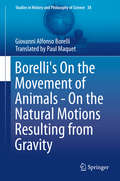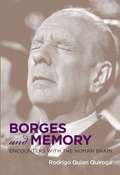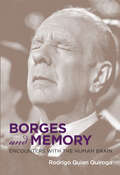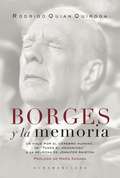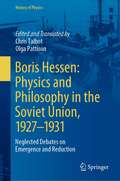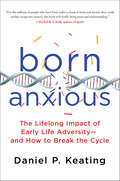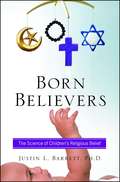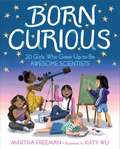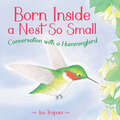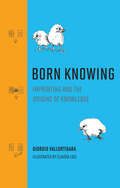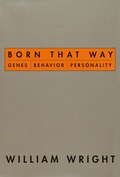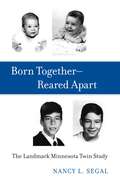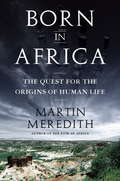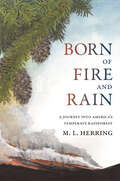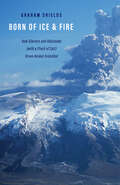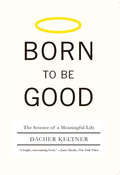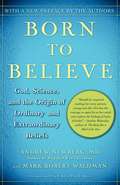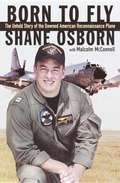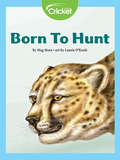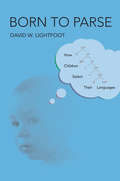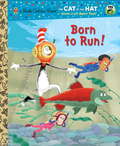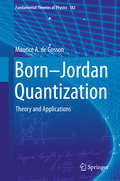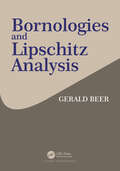- Table View
- List View
Borelli's On the Movement of Animals - On the Natural Motions Resulting from Gravity (Studies in History and Philosophy of Science #38)
by Giovanni Alfonso BorelliThis volume provides an introduction to Borelli's theory on the movement of animals and describes his theory and scientific experiments relating to the natural movements of bodies in a fluid environment. It describes in great detail why and how bodies which present with different magnitudes, weights and shapes move at a greater or a smaller velocity in certain proportion in the fluid environment. Originally published in Italian in 1667, then translated into Latin in 1686, the text of this volume has now been translated into English, making the text accessible to a wide readership. This volume is the second of two volumes that contain the Introduction and physical-mathematical illustrations necessary to understand Giovanni Alfonso Borelli's work On the Movement of Animals, the founding text of seventeenth century biomechanics. The first volume, entitled On the Force of Percussion, demonstrates the nature of the energy of percussion, its causes, properties and effects.
Borges and Memory
by Rodrigo Quian Quiroga Juan Pablo FernándezImagine the astonishment felt by neuroscientist Rodrigo Quian Quiroga when he found a fantastically precise interpretation of his research findings in a story written by the great Argentinian fabulist Jorge Luis Borges fifty years earlier. Quian Quiroga studies the workings of the brain--in particular how memory works--one of the most complex and elusive mysteries of science. He and his fellow neuroscientists have at their disposal sophisticated imaging equipment and access to information not available just twenty years ago. And yet Borges seemed to have imagined the gist of Quian Quiroga's discoveries decades before he made them. The title character of Borges's "Funes the Memorious" remembers everything in excruciatingly particular detail but is unable to grasp abstract ideas. Quian Quiroga found neurons in the human brain that respond to abstract concepts but ignore particular details, and, spurred by the way Borges imagined the consequences of remembering every detail but being incapable of abstraction, he began a search for the origins of Funes. Borges's widow, María Kodama, gave him access to her husband's personal library, and Borges's books led Quian Quiroga to reread earlier thinkers in philosophy and psychology. He found that just as Borges had perhaps dreamed the results of Quian Quiroga's discoveries, other thinkers--William James, Gustav Spiller, John Stuart Mill--had perhaps also dreamed a story like "Funes. " With Borges and Memory, Quian Quiroga has given us a fascinating and accessible story about the workings of the brain that the great creator of Funes would appreciate.
Borges and Memory: Encounters with the Human Brain
by Rodrigo Quian QuirogaA scientist's exploration of the working of memory begins with a story by Borges about a man who could not forget. Imagine the astonishment felt by neuroscientist Rodrigo Quian Quiroga when he found a fantastically precise interpretation of his research findings in a story written by the great Argentinian fabulist Jorge Luis Borges fifty years earlier. Quian Quiroga studies the workings of the brain—in particular how memory works—one of the most complex and elusive mysteries of science. He and his fellow neuroscientists have at their disposal sophisticated imaging equipment and access to information not available just twenty years ago. And yet Borges seemed to have imagined the gist of Quian Quiroga's discoveries decades before he made them.The title character of Borges's "Funes the Memorious" remembers everything in excruciatingly particular detail but is unable to grasp abstract ideas. Quian Quiroga found neurons in the human brain that respond to abstract concepts but ignore particular details, and, spurred by the way Borges imagined the consequences of remembering every detail but being incapable of abstraction, he began a search for the origins of Funes. Borges's widow, María Kodama, gave him access to her husband's personal library, and Borges's books led Quian Quiroga to reread earlier thinkers in philosophy and psychology. He found that just as Borges had perhaps dreamed the results of Quian Quiroga's discoveries, other thinkers—William James, Gustav Spiller, John Stuart Mill—had perhaps also dreamed a story like "Funes."With Borges and Memory, Quian Quiroga has given us a fascinating and accessible story about the workings of the brain that the great creator of Funes would appreciate.
Borges y la memoria: Un viaje por el cerebro humano. De "Funes el memorioso" a la neurona de Jennifer
by Rodrigo Quian Quiroga«El trabajo de Quian Quiroga demuestra su conocimiento de la obra deBorges y va dándonos de una manera inefable la unión o la premoniciónentre esa obra y su especialidad, la neurociencia». María Kodama La hiperconectividad del nuevo siglo determina, nos guste o no, un flujoinformativo permanente: vivimos pegados a una pantalla, recibiendodatos. Si no es la TV es el mail, o Facebook, o Twitter, o lacomputadora, o el sms que pasa de goteo a temporal. «Funes el memorioso»se ha hecho realidad: la información abruma y no hay tiempo paradetenerse a pensar. Desde esa perspectiva, el investigador argentinoRodrigo Quian Quiroga produce el extraordinario cruce entre lasneurociencias y la obra de Jorge Luis Borges, y con esas herramientas,que son las mejores posibles, se lanza a explorar los mecanismos querigen nuestra memoria, explica con deslumbrante claridad elcomportamiento de ciertas neuronas y se pone un traje de narrador sobreel uniforme del científico para que el viaje por el cerebro humano queensaya aquí sea tan divertido como revelador.
Boris Hessen: Neglected Debates on Emergence and Reduction (History of Physics)
by Chris Talbot Olga PattisonThis book presents key works of Boris Hessen, outstanding Soviet philosopher of science, available here in English for the first time. Quality translations are accompanied by an editors' introduction and annotations. Boris Hessen is known in history of science circles for his “Social and Economic Roots of Newton’s Principia” presented in London (1931), which inspired new approaches in the West. As a philosopher and a physicist, he was tasked with developing a Marxist approach to science in the 1920s. He studied the history of physics to clarify issues such as reductionism and causality as they applied to new developments. With the philosophers called the “Dialecticians”, his debates with the opposing “Mechanists” on the issue of emergence are still worth studying and largely ignored in the many recent works on this subject. Taken as a whole, the book is a goldmine of insights into both the foundations of physics and Soviet history.
Born Anxious: The Lifelong Impact of Early Life Adversity—and How to Break the Cycle
by Daniel P. KeatingWhy are we the way we are? Why do some of us find it impossible to calm a quick temper or to shake anxiety? The debate has always been divided between nature and nurture, but as psychology professor Daniel P. Keating demonstrates in Born Anxious, new DNA science points to a third factor that allows us to inherit both the nature and the nurture of previous generations—with significant consequences.Born Anxious introduces a new word into our lexicon: “methylated.” It’s short for “epigenetic methylation,” and it offers insight into behaviors we have all observed but never understood—the boss who goes ballistic at the slightest error; the infant who can’t be calmed; the husband who can’t fall asleep at night. In each case, because of an exposure to environmental adversity in utero or during the first year of life, a key stress system has been welded into the “on” position by the methylation process, predisposing the child’s body to excessive levels of the stress hormone cortisol. The effect: lifelong, unrelenting stress and its consequences–from school failure to nerve-wracking relationships to early death.Early adversity happens in all levels of society but as income gaps widen, social inequality and fear of the future have become the new predators; in Born Anxious, Daniel P. Keating demonstrates how we can finally break the cycle.
Born Believers: The Science of Children's Religious Belief
by Justin L. BarrettInfants have a lot to make sense of in the world: Why does the sun shine and night fall; why do some objects move in response to words, while others won’t budge; who is it that looks over them and cares for them? How the developing brain grapples with these and other questions leads children, across cultures, to naturally develop a belief in a divine power of remarkably consistent traits––a god that is a powerful creator, knowing, immortal, and good—explains noted developmental psychologist and anthropologist Justin L. Barrett in this enlightening and provocative book. In short, we are all born believers. Belief begins in the brain. Under the sway of powerful internal and external influences, children understand their environments by imagining at least one creative and intelligent agent, a grand creator and controller that brings order and purpose to the world. Further, these beliefs in unseen super beings help organize children’s intuitions about morality and surprising life events, making life meaningful. Summarizing scientific experiments conducted with children across the globe, Professor Barrett illustrates the ways human beings have come to develop complex belief systems about God’s omniscience, the afterlife, and the immortality of deities. He shows how the science of childhood religiosity reveals, across humanity, a “natural religion,” the organization of those beliefs that humans gravitate to organically, and how it underlies all of the world’s major religions, uniting them under one common source. For believers and nonbelievers alike, Barrett offers a compelling argument for the human instinct for religion, as he guides all parents in how to effectively encourage children in developing a healthy constellation of beliefs about the world around them.
Born Curious: 20 Girls Who Grew Up to Be Awesome Scientists
by Martha Freeman&“An inspiring look at women who realized curiosity plus tenacity equals success.&” —Kirkus Reviews Discover the histories of twenty incredible female scientists in this inspiring biography collection from beloved author Martha Freeman and Google Doodler Katy Wu.Why do galaxies spin the way they do? What&’s the best kind of house for a Komodo dragon? Can you cure malaria with medicine made from a plant? The scientists and mathematicians in Born Curious sought answers to these and many other fascinating questions. And it&’s lucky for us they did. Without their vision, insight, and hard work, the world would be a sicker, dirtier, and more dangerous place. The twenty groundbreaking women—including Rosalind Franklin, Marie Tharp, Shirley Anne Jackson, and more—came from all kinds of backgrounds and had all kinds of life experiences. Some grew up rich. Some grew up poor. Some were always the smartest kid in class. Some struggled to do well in school. But all had one thing in common: They were born curious. Are you curious, too? Read on.
Born Inside a Nest So Small
by Iza TrapaniA young child observes and admires a friendly ruby-throated hummingbird in this poetic love letter to the smallest birds in the world.A perfect rhyming and informative picture book about hummingbirds for curious 4-7-year-old backyard birders.Hummingbird, you nectar lover,how you dash and dart and hover—forward, backward, upside down.I love to watch you zip around.Admire a playful ruby-throated hummingbird alongside a young child, and learn about these birds&’ lives from teeniest tiniest egg to migrating south as the seasons change. With Iza Trapani&’s pleasing rhymes and gentle introduction to these little hummers, young readers will delight in repeat read alouds!Back matter includes further reading on hummingbirds for the most insatiable kids.
Born Knowing: Imprinting and the Origins of Knowledge
by Giorgio VallortigaraAn expert on the brain argues that the mind is not a blank slate and that much early behavior is biologically predisposed rather than learned.Why do newborns show a preference for a face (or something that resembles a face) over a nonface-like object? Why do baby chicks prefer a moving object to an inanimate one? Neither baby human nor baby chick has had time to learn to like faces or movement. In Born Knowing, neuroscientist Giorgio Vallortigara argues that the mind is not a blank slate. Early behavior is biologically predisposed rather than learned, and this instinctive or innate behavior, Vallortigara says, is key to understanding the origins of knowledge. Drawing on research carried out in his own laboratory over several decades, Vallortigara explores what the imprinting process in young chicks, paralleled by the cognitive feats of human newborns, reveals about minds at the onset of life. He explains that a preference for faces or representations of something face-like and animate objects--predispositions he calls "life detectors"--streamlines learning, allowing minds to avoid a confusing multiplicity of objects in the environment, and he considers the possibility that autism spectrum disorders might be linked to a deficit in the preference for the animate. He also demonstrates that animals do not need language to think, and that addition and subtraction can be performed without numbers. The origin of knowledge, Vallortigara argues, is the wisdom that humans and animals possess as basic brain equipment, the product of natural history rather than individual development.
Born That Way
by William WrightTaking the nature vs. nurture debate to a new level, this fascinating, comprehensive journey into the world of genetic research and molecular biology offers a fresh assessment of the work that has been done in this relatively new field during the last half century-work that has demolished common assumptions and overturned existing theories about what determines our personality and behavior.
Born Together--Reared Apart
by Nancy L. SegalThe identical Jim twins were raised in separate families and met for the first time at age thirty-nine, only to discover that they both suffered tension headaches, bit their fingernails, smoked Salems, enjoyed woodworking, and vacationed on the same Florida beach. This example of the potential power of genetics captured widespread media attention in 1979 and inspired the Minnesota Study of Twins Reared Apart. This landmark investigation into the nature-nurture debate shook the scientific community by demonstrating, across a number of traits, that twins reared separately are as alike as those raised together. As a postdoctoral fellow and then as assistant director of the Minnesota Study, Nancy L. Segal provides an eagerly anticipated overview of its scientific contributions and their effect on public consciousness. The study’s evidence of genetic influence on individual differences in traits such as personality (50%) and intelligence (70%) overturned conventional ideas about parenting and teaching. Treating children differently and nurturing their inherent talents suddenly seemed to be a fairer approach than treating them all the same. Findings of genetic influence on physiological characteristics such as cardiac and immunologic function have led to more targeted approaches to disease prevention and treatment. And indications of a stronger genetic influence on male than female homosexuality have furthered debate regarding sexual orientation.
Born in Africa: The Quest for the Origins of Human Life
by Martin MeredithAfrica does not give up its secrets easily. Buried there lie answers to the origins of humankind. After a century of investigation, scientists have transformed our understanding about the beginnings of human life. Many remarkable discoveries have been made. Yet even as the evidence about human evolution has continued to grow, so the riddle has become ever more complex. And ultimate clues still remain hidden. Born in Africa tells the scintillating true story of the scientists who have striven to uncover the mysteries of human origins over the past hundred years. Through a dramatic and persuasive narrative Martin Meredith recreates the excitement and the danger of their journey as well as celebrating the momentous discoveries yielded by their quest. Scientists have identified more than twenty species of extinct humans. They have firmly established Africa as the birthplace not only of humankind but also of modern humans. And they have shown how modern humans, possessing a wide range of skills and language ability, spread out from Africa in an exodus sixty thousand years ago to populate the rest of the world. We have all inherited an African past.
Born of Fire and Rain: Journey into a Pacific Coastal Forest
by M. L. HerringGo beyond the scenery of the Pacific temperate rainforest to witness how complex ecosystems survive in a world of upheavals If you live on a rapidly changing planet, you&’d be wise to learn how it works. The giant old forests on a skinny stretch of land on the far west coast of North America have a lot to say about living in a twitchy world. In this engaging book science writer M. L. Herring takes readers into the Pacific temperate rainforest at the tumultuous edge of a shifting continent in a precarious moment of time. Readers peek behind the magnificent scenery into a forest of ancient trees, exploding mountains, disappearing owls, tsunamis, megafires, and ten million people to learn what it means to be a forest in a world of upheavals. Through Herring&’s words and pictures, readers drift into the canopy through masses of ferns and lichens, burrow into soil through hair-thin threads of fungi, and plunge headlong through a watershed flushed with rain and snowmelt. Readers experience the temperate rainforest through science and art as it faces a shifting climate and the shifting priorities of a constantly changing society. The book journeys beyond the grid of latitude and longitude and into places only one&’s imagination can fit, to discover what it means to be human in an ecological world.
Born of Ice and Fire: How Glaciers and Volcanoes (with a Pinch of Salt) Drove Animal Evolution
by Graham ShieldsAn exploration of how the Cryogenian Period, when our planet was covered in ice for millions of years, created today&’s remarkable biodiversity More than half a billion years ago, our world was completely covered by glaciers, a &“Snowball Earth&” that persisted for millions of years. Incredibly, this unimaginable cold led to the remarkable diversification of life on earth known as the Cambrian explosion. With a geologist&’s eye and a knack for storytelling, Graham Shields explores when and how such inhospitable conditions enabled animals to evolve, radiate, and diversify into our earliest ancestors. This journey navigates the wild swings between hot and cold climates, oxygenation and asphyxiation, biological radiations and extinctions, asking how such instability relates to grander forces that brought our planet to its modern state. Shields guides readers through evidence found in the Australian outback, Mongolia, Scotland, and other locales, revealing how geologists can trace glaciation, the atmosphere, oceans, mountain building, and more through the earth&’s rocks, providing a comprehensive theory of how life evolved and diversified.
Born to Be Good: The Science of a Meaningful Life
by Dacher Keltner"A landmark book in the science of emotions and its implications for ethics and human universals."--Library Journal, starred review In this startling study of human emotion, Dacher Keltner investigates an unanswered question of human evolution: If humans are hardwired to lead lives that are "nasty, brutish, and short," why have we evolved with positive emotions like gratitude, amusement, awe, and compassion that promote ethical action and cooperative societies? Illustrated with more than fifty photographs of human emotions, Born to Be Good takes us on a journey through scientific discovery, personal narrative, and Eastern philosophy. Positive emotions, Keltner finds, lie at the core of human nature and shape our everyday behavior--and they just may be the key to understanding how we can live our lives better.
Born to Believe
by Andrew Newberg Mark Robert WaldmanBorn to Believe was previously published in hardcover as Why We Believe What We Believe. Prayer...meditation...speaking in tongues. What do these spiritual activities share and how do they differ? Why do some people believe in God, while others embrace atheism? From the ordinary to the extraordinary, beliefs give meaning to the mysteries of life. They motivate us, provide us with our individual uniqueness, and ultimately change the structure and function of our brains. In Born to Believe, Andrew Newberg, MD, and Mark Waldman reveal -- for the very first time -- how our complex views, memories, superstitions, morals, and beliefs are created by the neural activities of the brain. Supported by groundbreaking original research, they explain how our brains construct our deepest convictions and fondest assumptions about reality and the world around us. Using science, psychology, and religion, the authors offer recommendations for exercising your brain in order to develop a more life-affirming, flexible range of attitudes. Knowing how the brain builds meaning, value, spirituality, and truth into your life will change forever the way you look at yourself and the world.
Born to Believe: God, Science, and the Origin of Ordinary and Extraordinary Beliefs
by Andrew Newberg Mark Robert WaldmanBorn to Believe was previously published in hardcover as Why We Believe What We Believe. Prayer...meditation...speaking in tongues. What do these spiritual activities share and how do they differ? Why do some people believe in God, while others embrace atheism? From the ordinary to the extraordinary, beliefs give meaning to the mysteries of life. They motivate us, provide us with our individual uniqueness, and ultimately change the structure and function of our brains. In Born to Believe, Andrew Newberg, MD, and Mark Waldman reveal -- for the very first time -- how our complex views, memories, superstitions, morals, and beliefs are created by the neural activities of the brain. Supported by groundbreaking original research, they explain how our brains construct our deepest convictions and fondest assumptions about reality and the world around us. Using science, psychology, and religion, the authors offer recommendations for exercising your brain in order to develop a more life-affirming, flexible range of attitudes. Knowing how the brain builds meaning, value, spirituality, and truth into your life will change forever the way you look at yourself and the world.
Born to Fly
by Shane OsbornThe riveting and inspiring story of how Navy Lieutenant Shane Osborn's flying skills saved a Navy reconnaissance plane and its crew of 24 from almost certain death, and their subsequent ordeal of detention and interrogation. On April 1, 2001, aircraft commander Shane Osborn was piloting an EP-3 ARIES II reconnaissance plane over the South China Sea when it was suddenly intercepted and harassed by two Chinese F-8 fighters. On earlier missions the Chinese had flown dangerously close to American aircraft in a nerve-wracking game of chicken. This time, however, one of the Chinese fighters went too far, colliding with Osborn's plane and being hacked in two by one of its props, in the process inflicting catastrophic damage on the EP-3. With almost certain disaster impending, Lieutenant Osborn, using the aviation skills of a superbly trained pilot and the strength and endurance of a natural athlete, managed to recover from a near-inverted dive and avoid either ditching the plane in the sea or having the crew bail out, both potentially fatal maneuvers. Instead he and his crew were able to fly their crippled aircraft through harrowing circumstances to a safe emergency landing on the Chinese island of Hainan. Chinese military forces immediately took the crew into detention. Meanwhile, an international political crisis, the first of the new Bush administration, erupted between the United States and China as each superpower attempted to force blame on the other. Lieutenant Osborn, oblivious to the proceedings in the outside world, was separated from the rest of his crew and isolated in an interrogation room where he was subjected to hour upon hour of aggressive and repetitive videotaped questioning. Osborn, maintaining an iron will throughout, resisted the interrogators' demands that he accept responsibility for the collision and apologize. Finally the two governments were able to work out an agreement for the release of the crew after being held for eleven days. Born to Fly takes us right into the cockpit of the reconnaissance plane on that fateful day, in a white-knuckle tale of heroism and split-second decision making. It also weaves in fascinating stories of Lieutenant Osborn's insatiable desire to fly from early childhood and the Naval training that gave him the "right stuff" to handle the crisis in the air and on land. A portrait of a genuine American hero, Born to Fly gives unprecedented insight into one of the most dramatic incidents of the post-Cold War world.
Born to Parse: How Children Select Their Languages
by David W. LightfootAn argument that children are born to assign structures to their ambient language, which feeds a view of language variation not based on parameters defined at UG. In this book, David Lightfoot argues that just as some birds are born to chirp, humans are born to parse--predisposed to assign linguistic structures to their ambient external language. This approach to language acquisition makes two contributions to the development of Minimalist thinking.
Born to Run! (Little Golden Book)
by Tish RabeWhen Nick wants to go on an adventure and Sally wants to go swimming, the Cat in the Hat knows where they can do both—alongside Salmon Sam on her incredible journey up the Swirly Whirly River! Shrunk to the size of salmon and swimming in scuba gear, the Cat and kids join Sam as she swims against the current, jumps up waterfalls, and avoids being eaten by a grizzly bear in her quest to return to the pool of water where she was born to lay her eggs. This Little Golden Book is fine fishy fun for reading on a summer day, and at only $3.99—it's almost as incredible as Sam's journey!
Born-Jordan Quantization: Theory and Applications (Fundamental Theories of Physics #182)
by Maurice A. de GossonThis book presents a comprehensive mathematical study ofthe operators behind the Born-Jordan quantization scheme. The Schrödinger andHeisenberg pictures of quantum mechanics are equivalent only if the Born-Jordanscheme is used. Thus, Born-Jordan quantization provides the only physicallyconsistent quantization scheme, as opposed to the Weyl quantization commonlyused by physicists. In this book we develop Born-Jordan quantization from anoperator-theoretical point of view, and analyze in depth the conceptualdifferences between the two schemes. We discuss various physically motivatedapproaches, in particular the Feynman-integral point of view. One important andintriguing feature of Born-Jordan quantization is that it is not one-to-one:there are infinitely many classical observables whose quantization is zero.
Bornologies and Lipschitz Analysis
by Gerald BeerThis monograph, for the first time in book form, considers the large structure of metric spaces as captured by bornologies: families of subsets that contain the singletons, that are stable under finite unions, and that are stable under taking subsets of its members. The largest bornology is the power set of the space and the smallest is the bornology of its finite subsets. Between these lie (among others) the metrically bounded subsets, the relatively compact subsets, the totally bounded subsets, and the Bourbaki bounded subsets. Classes of functions are intimately connected to various bornologies; e.g., (1) a function is locally Lipschitz if and only if its restriction to each relatively compact subset is Lipschitz; (2) a subset is Bourbaki bounded if and only if each uniformly continuous function on the space is bounded when restricted to the subset. A great deal of attention is given to the variational notions of strong uniform continuity and strong uniform convergence with respect to the members of a bornology, leading to the bornology of UC-subsets and UC-spaces. Spaces on which its uniformly continuous real-valued functions are stable under pointwise product are characterized in terms of the coincidence of the Bourbaki bounded subsets with a usually larger bornology. Special attention is given to Lipschitz and locally Lipschitz functions. For example, uniformly dense subclasses of locally Lipschitz functions within the real-valued continuous functions, Cauchy continuous functions, and uniformly continuous functions are presented. It is shown very generally that a function between metric spaces has a particular metric property if and only if whenever it is followed in a composition by a real-valued Lipschitz function, the composition has the property. Bornological convergence of nets of closed subsets, having Attouch-Wets convergence as a prototype, is considered in detail. Topologies of uniform convergence for continuous linear operators between normed spaces is explained in terms of the bornological convergence of their graphs. Finally, the idea of a bornological extension of a topological space is presented, and all regular extensions can be so realized.
Boron Hydrides (Dover Books on Chemistry)
by William N. LipscombIn this classic monograph, Nobel Prize–winning chemist William N. Lipscomb elucidates his area of expertise: the general structural principles and reactions of boron hydrides and related compounds. Lipscomb's work appeared only a decade after the structures of boron hydrides were first elucidated and their chemistry formulated into a widely applicable framework. His observations led to a major reconsideration of how atoms bond to form stable molecules.A concise treatment of the many separate parts of the structural theory and its relation to chemistry, this volume begins with an overview of boron hydrides and related structures, progressing to three-center bonds and their applications, molecular orbitals, nuclear magnetic resonance studies of boron hydrides and related compounds, and reactions of the boron hydrides. More than 120 diagrams and figures illustrate a variety of structures.
